Paper Menu >>
Journal Menu >>
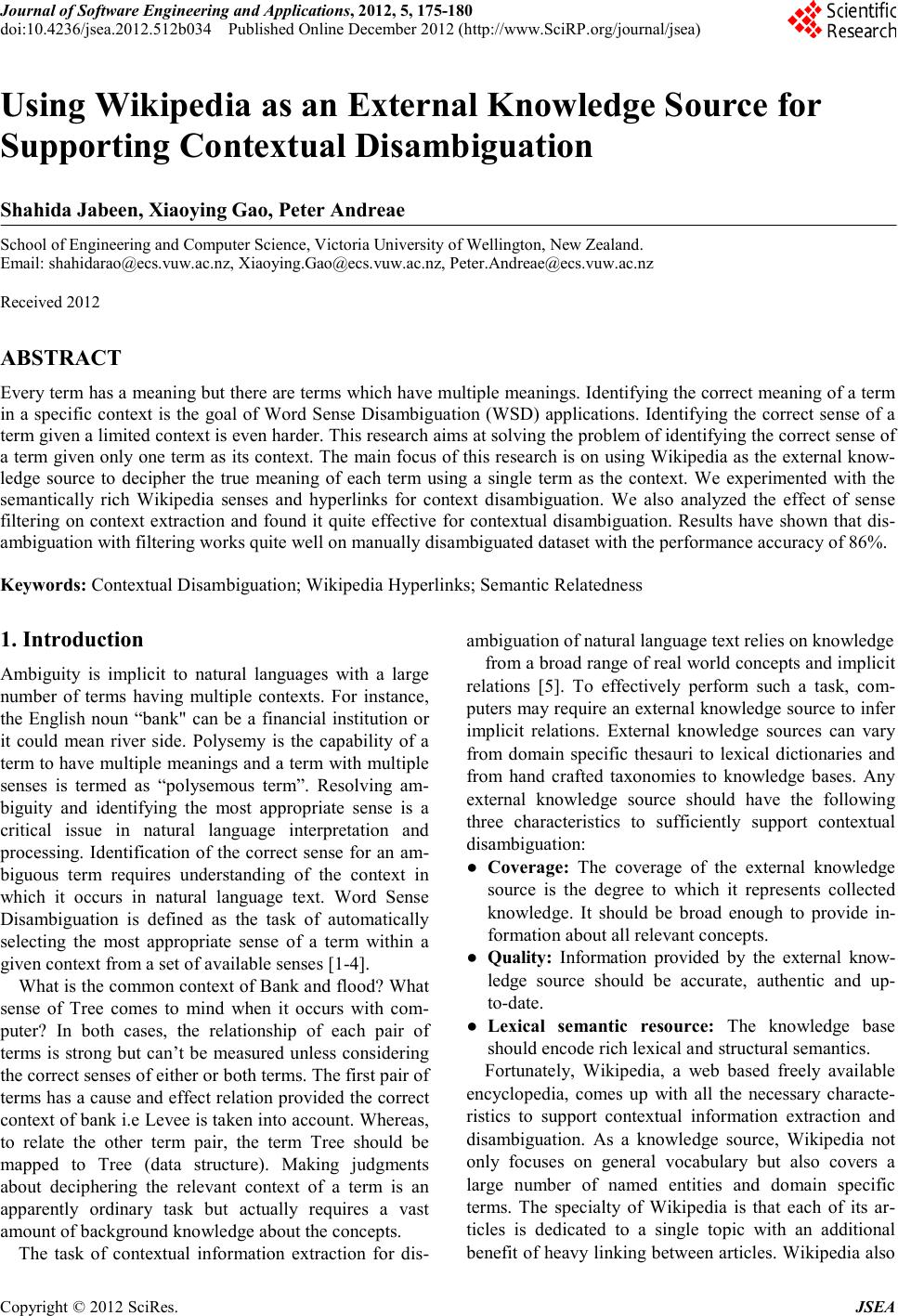 Journal of Software Engineering and Applications, 20 12, 5, 175-180 doi:10.4236 /js ea.2012.512b034 Published Online December 2012 (http://www.SciRP.org/journal/jsea) Copyright © 2012 SciRes. JSEA 175 Using Wikipedia as an External Knowledge Source for Supporting Contextual Disambiguation Shahida Jabeen, Xiaoying Gao, Peter Andreae School of Engineering and Computer Science, Victoria University of Wellington, New Zealand. Email: shahidar ao@ecs.vuw.ac.nz, Xiaoying. Gao@ ecs .vuw.a c.nz, Peter.Andreae@ecs.vuw.ac.nz Received 2012 ABSTRACT Every term has a meaning but there are terms which ha ve mult iple mea ning s. Ident ifyin g the cor rect mea ning o f a term in a specific context is the goal of Word Sense Disambiguation (WSD) applications. Identifying the correct sense of a ter m give n a l i mited c ont e xt i s eve n har d er . Thi s research aims at solving the problem of identifying the correct sense of a ter m give n only one term as its conte xt. The main focus of this research is on using Wikipedia as the external know- ledge source to decipher the true meaning of each term using a single term as the context. We experimented with the semantically rich Wikipedia senses and hyperlinks for context disambiguation. We also analyzed the effect of sense filtering on context extraction and found it quite effective for contextual disambiguatio n. Results have sho wn that dis- ambiguatio n with filtering works quite wel l on manually disambiguated dataset with the performance accuracy of 86%. Keywords: Contextual Disambiguatio n; Wikipedia Hyperlinks; Se mantic Related ne ss 1. Introduction Ambiguity is implicit to natural languages with a large number of terms having multiple contexts. For instance, the English noun “bank" can be a financial institution or it could mean river side. Polysemy is the capability of a term to have multip le meanings and a term with multip le senses is termed as “polysemous term”. Resolving am- biguity and identifying the most appropriate sense is a critical issue in natural language interpretation and processing. Identification of the correct sense for an am- biguous term requires understanding of the context in which it occurs in natural language text. Word Sense Disa mbiguation is defined as the task of automatically selecting the most appropriate sense of a term within a given context fro m a set of available senses [1-4]. What is the co mmo n cont ext of B ank a nd floo d? What sense of Tree comes to mind when it occurs with com- puter? In both cases, the relationship of each pair of terms is strong but can’t be measured unless considering the correct senses of either or both terms. The first pair of terms has a cause and effect relation provided the correct context of bank i.e Levee is taken into account. Whereas, to relate the other term pair, the term Tree should be mapped to Tree (data structure). Making judgments about deciphering the relevant context of a term is an apparently ordinary task but actually requires a vast amount of background knowledge about the concepts. The task of contextual information extraction for dis- ambiguatio n of natur al language te xt relies o n knowledge from a broad range of real world concepts and implicit relations [5]. To effectively perform such a task, com- puters ma y r eq ui re an external knowledge source to infer implicit relations. External knowledge sources can vary from domain specific thesauri to lexical dictionaries and from hand crafted taxonomies to knowledge bases. Any external knowledge source should have the following three characteristics to sufficiently support contextual disambi guation: ● Coverage: The coverage of the external knowledge source is the degree to which it represents collected knowledge. It should be broad enough to provide in- formation about all relevant concepts. ● Quality: Information provided by the external know- ledge source should be accurate, authentic and up- to-date. ● Lexical semantic resource: The knowledge base should encode rich lexical and structural semantics. Fortunately, Wikipedia, a web based freely available encyclopedia, comes up with all the necessary characte- ristics to support contextual information extraction and disambi guation. As a knowledge source, Wikipedia not only focuses on general vocabulary but also covers a large number of named entities and domain specific terms. The specialty of Wikipedia is that each of its ar- ticles is dedicated to a single topic with an additional bene fit of heavy li nkin g between articles. Wikipedia also 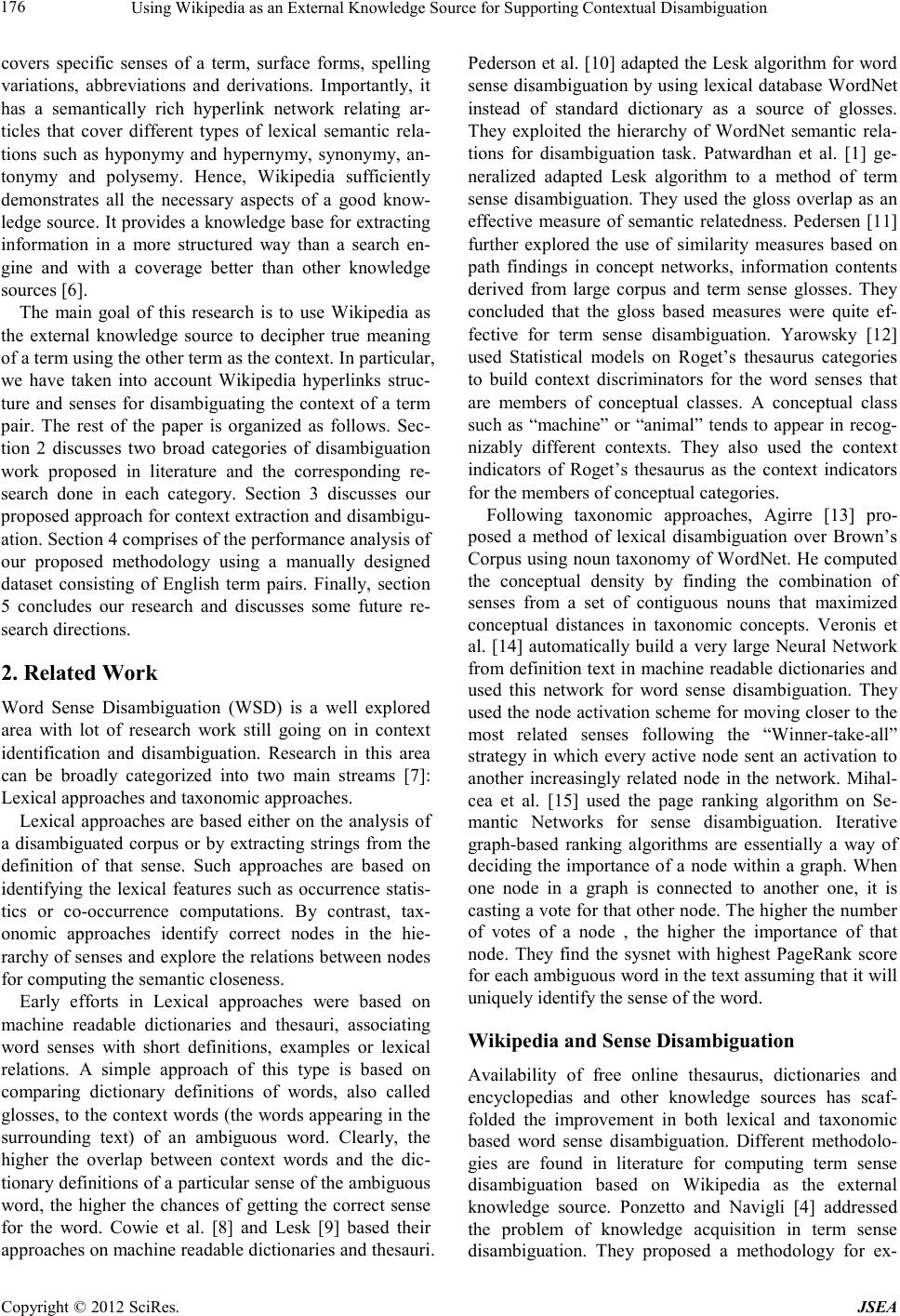 Using Wikipedia as an External Knowledge Source for Supporting Contextual Disambiguation Copyright © 2012 SciRes. JSEA 176 covers specific senses of a term, surface forms, spelling variations, abbreviations and derivations. Importantly, it has a semantically rich hyperlink network relating ar- ticles that cover different types of lexical semantic rela- tions such as hyponymy and hypernymy, synonymy, an- tonymy and polysemy. Hence, Wikipedia sufficiently demonstrates all the necessary aspects of a good know- ledge source. It provides a knowledge base for extracting information in a more structured way than a search en- gine and with a coverage better than other knowledge sources [6]. The main goal of this research is to use Wikipedia as the external knowledge source to decipher true meaning of a term using the other term as the context. In particular, we have taken into account Wikipedia hyperlinks struc- ture and senses for disambiguating the context of a term pair. The rest of the paper is organized as follows. Sec- tion 2 discusses two broad categories of disambiguation work proposed in literature and the corresponding re- search done in each category. Section 3 discusses our proposed approach for context extraction and disambigu- ation. Sectio n 4 comprises of the perfor mance analysis o f our proposed methodology using a manually designed dataset consisting of English term pairs. Finally, section 5 concludes our research and discusses some future re- search directions. 2. Related Work Word Sense Disambiguation (WSD) is a well explored area with lot of research work still going on in context identification and disambiguation. Research in this area can be broadly categorized into two main streams [7]: Lexical approaches and taxonomic approaches. Lexical approaches are based either on the analysis of a disambiguated corpus or by extracting strings from the definition of that sense. Such approaches are based on identifying the lexical features such as occurrence statis- tics or co-occurrence computations. By contrast, tax- onomic approaches identify correct nodes in the hie- rarc hy of sense s and explore the relations between nodes for c omputing t he semantic closeness. Early efforts in Lexical approaches were based on machine readable dictionaries and thesauri, associating word senses with short definitions, examples or lexical relations. A simple approach of this type is based on comparing dictionary definitions of words, also called glosse s, to the co ntex t words (the words appearing in the surrounding text) of an ambiguous word. Clearly, the higher the overlap between context words and the dic- tionary definitio ns of a particular sense of the ambiguous word, the higher the chances of getting the correct sense for the word. Cowie et al. [8] and Lesk [9] based their approaches on machine readable dictionaries and thesauri. Pederson et al. [10] adapted the Lesk algorithm for word sense disambiguation by using lexical database WordNet instead of standard dictionary as a source of glosses. They exploited the hierarchy of WordNet semantic rela- tions for disambiguation task. Patwardhan et al. [1] ge- neralized adapted Lesk algorithm to a method of term sense disambiguation. They used the gloss overlap as an effective measure of semantic relatedness. Pedersen [11] further explored the use of similarity measures based on path findings in concept networks, information contents derived from large corpus and term sense glosses. They concluded that the gloss based measures were quite ef- fective for term sense disambiguation. Yarowsky [12] used Statistical models on Roget’s thesaurus categories to build context discriminators for the word senses that are members of conceptual classes. A conceptual class such as “machine” or “animal” tends to appear in recog- nizably different contexts. They also used the context indicators of Roget’s thesaurus as the context indicators for the members of conceptual categories. Following taxonomic approaches, Agirre [13] pro- posed a method of lexical disambiguation over Brown’s Corpus using no un taxo nomy of Word Net. He computed the conceptual density by finding the combination of senses from a set of contiguous nouns that maximized conceptual distances in taxonomic concepts. Veronis et al. [14] automatically build a very large Neural Network from definitio n text in machine readable dictionaries and used this network for word sense disambiguation. They used the node activation scheme for moving closer to the most related senses following the “Winn er-take-all” strategy in which every active node sent an activation to another increasingly related node in the network. Mihal- cea et al. [15] used the page ranking algorithm on Se- mantic Networks for sense disambiguation. Iterative graph-based ranking algorithms are essentially a way of deciding the importance of a node within a graph. When one node in a graph is connected to another one, it is casting a vote for that other node. The higher the number of votes of a node , the higher the importance of that node. They find the sysnet with highest PageRank score for each ambiguous word in the text as suming that it will uniquely identify t he sense of the word. Wikipedia and Sense Disambiguation Availability of free online thesaurus, dictionaries and encyclopedias and other knowledge sources has scaf- folded the improvement in both lexical and taxonomic based word sense disambiguation. Different methodolo- gies are found in literature for computing term sense disambiguation based on Wikipedia as the external knowledge source. Ponzetto and Navigli [4] addressed the problem of knowledge acquisition in term sense disambiguation. They proposed a methodology for ex- 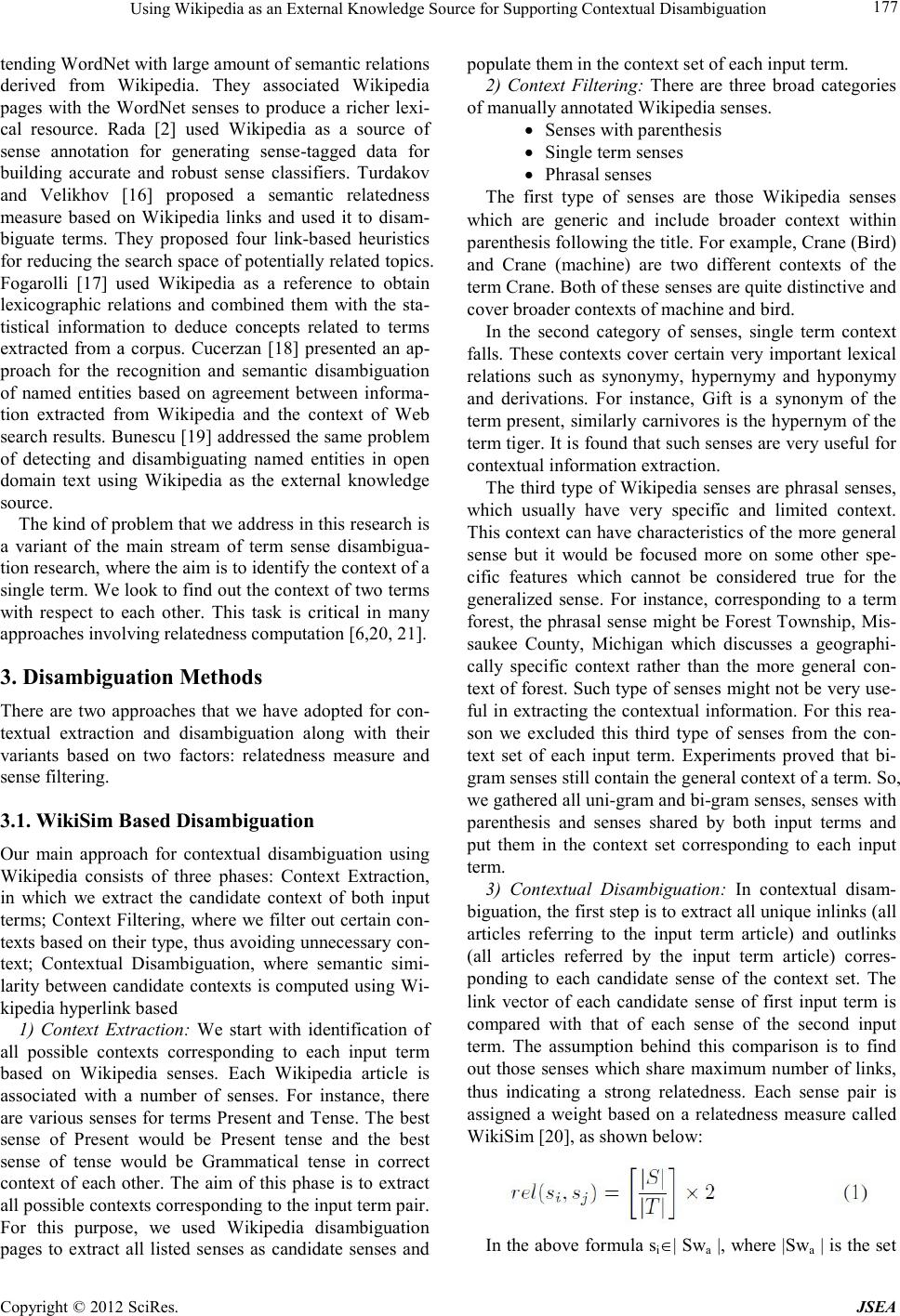 Using Wikipedia as an External Knowledge Source for Supporting Contextual Disambiguation Copyright © 2012 SciRes. JSEA 177 tending Wor dNet with large amount of semantic relatio ns derived from Wikipedia. They associated Wikipedia pages with the WordNet senses to produce a richer lexi- cal resource. Rada [2] used Wikipedia as a source of sense annotation for generating sense-tagged data for building accurate and robust sense classifiers. Turdakov and Velikhov [16] proposed a semantic relatedness measure based on Wikipedia links and used it to disam- biguate terms. They proposed four link-based heuristics for r educ ing t he searc h space of potentially related topics. Fogarolli [17] used Wikipedia as a reference to obtain lexicographic relations and combined them with the sta- tistical information to deduce concepts related to terms extracted from a corpus. Cucerzan [18] presented an ap- proach for the recognition and semantic disambiguation of named entities based on agreement between informa- tion extracted from Wikipedia and the context of Web search results. Bunescu [19] addressed the same problem of detecting and disambiguating named entities in open domain text using Wikipedia as the external knowledge source. The kind of pro blem that we add ress in this research is a variant of the main stream of term sense disambigua- tion research, where the aim is to identify the context of a single term. We look to find o ut the co ntext of two ter ms with respect to each other. This task is critical in many approaches involving r elatedness computation [6,20, 21]. 3. Disambiguation Methods There are two approaches that we have adopted for con- textual extraction and disambiguation along with their variants based on two factors: relatedness measure and sense filte rin g. 3.1. WikiSim Based Disambiguation Our main approach for contextual disambiguation using Wikipedia consists of three phases: Context Extraction, in which we extract the candidate context of both input terms ; Context Filtering, where we filter o ut certain co n- texts based on t heir t ype, th us avo iding u nnece ssar y con- text; Contextual Disambiguation, where semantic simi- larity between candidate contexts is computed using Wi- kipedia hyperlink based 1) Context Extraction: We start with identification of all possible contexts corresponding to each input term based on Wikipedia senses. Each Wikipedia article is associated with a number of senses. For instance, there are various senses for terms Present and Tense. T he best sense of Present would be Present tense and the best sense of tense would be Grammatical tense in correct context of each other. The aim of this phase is to extract all possible co ntexts corr espond ing to the inpu t ter m pair. For this purpose, we used Wikipedia disambiguation pages to extract all listed senses as candidate senses and populate them in the conte xt set of each inp ut term. 2) Context Filtering: There are three broad categories of manually annotate d Wikipedia senses. • Senses with parenthesi s • Single term senses • Phrasal senses The first type of senses are those Wikipedia senses which are generic and include broader context within parenthesis followin g the title. Fo r exa mple, Crane (B ird ) and Crane (machine) are two different contexts of the term Crane. Both of these senses are quite distinctive and cover broader contexts of machine and bird . In the second category of senses, single term context falls. These contexts cover certain very important lexical relations such as synonymy, hypernymy and hyponymy and derivations. For instance, Gift is a synonym of the term present, similarly carnivores is the hypernym of the ter m tiger . I t is fou nd tha t s uc h sense s a re ver y use ful for contextual information extr act ion. The third type of Wikipedia senses are phrasal senses, which usually have very specific and limited context. This context can have characteristics of the more general sense but it would be focused more on some other spe- cific features which cannot be considered true for the generalized sense. For instance, corresponding to a term forest, the phrasal sense might be Forest Township, Mis- saukee County, Michigan which discusses a geographi- cally specific context rather than the more general con- text of forest. Such type of senses might not be ver y u se- ful in extracting the contextual information. For this rea- son we excluded this third type of senses from the con- text set of each input term. Experiments proved that bi- gram senses still contain the general context of a term. So, we gathered all uni-gra m and b i-gra m senses, se nses wit h parenthesis and senses shared by both input terms and put them in the context set corresponding to each input term. 3) Contextual Disambiguation: In contextual disam- biguation, the first step is to extract all uniq ue inlinks (all articles referring to the input term article) and outlinks (all articles referred by the input term article) corres- ponding to each candidate sense of the context set. The link vector of each candidate sense of first input term is compared with that of each sense of the second input term. The assumption behind this comparison is to find out those se nses which share maximum number of links, thus indicating a strong relatedness. Each sense pair is assigned a weight based on a relatedness measure called WikiS im [20] , as shown below: In the above formula si∈| Swa |, where |Swa | i s the set 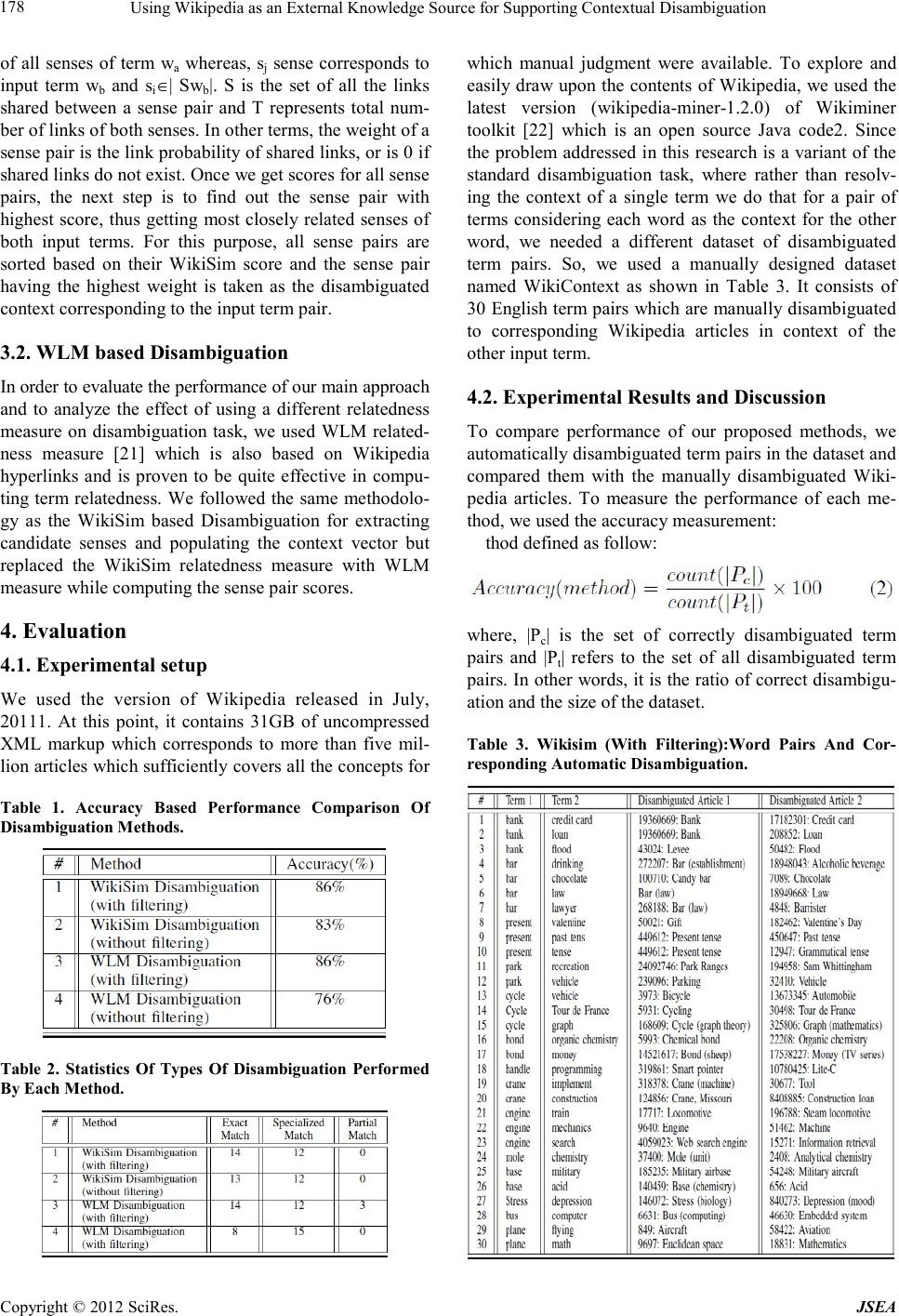 Using Wikipedia as an External Knowledge Source for Supporting Contextual Disambiguation Copyright © 2012 SciRes. JSEA 178 of all senses of term wa whereas, sj sense corresponds to input term wb and si∈| Swb|. S is the set of all the links shared between a sense pair and T represents total num- ber of links of both senses. In other terms, the weight of a sense p air is the link probability of shared links, or is 0 if shared links do not exist. Onc e we get scores for all sense pair s, the next step is to find out the sense pair with highest score, thus getting most closely related senses of both input terms. For this purpose, all sense pairs are sorted based on their WikiSim score and the sense pair having the highest weight is taken as the disambiguated context corresponding to the input term p a ir . 3.2. WLM based Disambiguation In or d er to e va l ua t e t he pe r fo r ma nc e o f our ma i n a pproach and to analyze the effect of using a different relatedness measure on disambiguation task, we used WLM related- ness measure [21] which is also based on Wikipedia hyperlinks and is proven to be quite effective in compu- ting term relatedness. We followed the same methodolo- gy as the WikiSim based Disambiguation for extracting candidate senses and populating the context vector but replaced the WikiSim relatedness measure with WLM measure while computing the sense pair scores. 4. Evaluation 4.1. Experimental setup We used the version of Wikipedia released in July, 20111. At this point, it contains 31GB of uncompressed XML markup which corresponds to more than five mil- lion articles which sufficiently covers all the co ncepts for Table 1. Accuracy Based Performance Comparison Of Disambiguation M e thods. Table 2. Statistics Of Types Of Disambiguation Performed By Each Metho d. which manual judgment were available. To explore and easily draw upon the contents of Wikipedia, we used the latest version (wi kiped ia-miner-1.2.0) of Wikiminer toolkit [22] which is an open source Java code2. Since the problem addressed in this research is a variant of the standard disambiguation task, where rather than resolv- ing the context of a single term we do that for a pair of terms considering each word as the context for the other word, we needed a different dataset of disambiguated term pairs. So, we used a manually designed dataset named WikiContext as shown in Table 3. It consists of 30 E nglish ter m pair s which ar e manual ly disa mbi guated to corresponding Wikipedia articles in context of the other input term. 4.2. Experimental Results and Discussion To compare performance of our proposed methods, we automatically disambiguated term pairs in the dataset and compared them with the manually disambiguated Wiki- pedia articles. To measure the performance of each me- thod, we used the accuracy measurement: thod defined as follow: where, |Pc| is the set of correctly disambiguated ter m pairs and |Pt| refers to the set of all disambiguated term pairs. In other words, it is the ratio o f correct disambigu- ation and t he size of the dataset. Table 3. Wikisim (With Filtering):Word Pairs And Cor- respo nding Aut omatic Disambiguation.  Using Wikipedia as an External Knowledge Source for Supporting Contextual Disambiguation Copyright © 2012 SciRes. JSEA 179 When compared performance accuracy of both Wiki- Sim based disambiguation and WLM based disambigua- tion, WikiSim based disambiguation is found to be com- parable to that of WLM based disa mbiguation, both hav- ing an accuracy of 86% as shown in Table I. To analyze the effect o f applying sense filterin g in both disambigua- tion approaches, we skipped context filtering step from each approach and performed disambiguation with all possible contexts. Detailed analysis of each approach is summarized in Table II. Three types of disambiguation are taken into account in this research: First, those word pairs which are matched exactly to the manual disam- biguat ion; se co nd , those word pairs which are matched to a specialized area or subtopic of the correct context; third, those word pairs in which one of the term is correctly disambiguated in context of the other word but the other term is disambiguated to a wrong context. Results of WikiSim based disambiguation revealed that there was no partial match in case of both context filtering and without filtering. Whereas, some of the specialized matches were found to be more relevant then the exact matches. For example in case of the term pair <mole, chemistry>, mole was disambiguated exactly to Mole (unit) which is the measurement of amount of chemical substance but che mistry was disambi guated to even mor e related context Analytical Chemistry which deals with quantification of the chemical components. Similarly, the term pair <bar, drinking> was disambiguated to <Bar (Establishment), Alcoholic beverages>. In case of WLM based disambiguation with filtering, three term pairs were found to be partially matched to the correct context. Table III shows the results on WikiSim based disambig- uation (with filtering) on the dataset WikiContext. It shows disambiguated Wikipedia articles corresponding to input term pairs. Table I Accuracy Based Performance Comparison Of Disam- biguation Method s Overall, disambiguation based on filtering is found to be better than the one without filtering. The accuracy of WikiSim based method is 3% increased when filtering is applied. The effect of filtering became more evident in WLM where the accuracy of filtering based disambigua- tion increased to 10%. The results of our main approach are quite encouraging and comparable to the WLM based disambiguation. In order to avoid any bias in the results due to smaller size of dataset and to test the effectiveness of our approach more critically, we plan to use some bigger dataset in future. To the best of our knowledge, there is no dataset available that addresses this particular kind of pro blem. One li mitati on of our approach is that it relies heavily on Wikipedia senses, which are manually encoded and may not sufficiently cover all possible con- texts of so me terms and suffers from inco nsiste nt for mat- ting d ue to manua l e ncod ing. We bel ieve tha t usi ng o ther Wikipedia features such as anchor text s , categories, hyperlinks and redirects for semantic extraction would definitely help in t his regard. 5. Conclusion In this paper we proposed and evaluated a novel approach for extracting contextual information from Wikipedia and using it to d isambi guate a term using a single ter m as a given context. Based on Wikipedia hyperlink structure and senses, our approach used WikiSim, a Wikipedia based relatedness measure to compute scores of sense pairs and compare them based on their relatedness. For the sense disambiguation, we extracted various senses of first input term and disambiguated each sense in various contexts of the other input term. We evaluated the per- formance of our approach by comparing it with WLM based disambiguation approach and analyzed the effect of context filtering disambiguation. Results have shown that with an accuracy of 86%, our approach performs quite well when compared with manually disambiguated dataset of term pairs. In future, we plan to apply this disambiguation approach along with the semantic rela- tedness in key phrase clustering task for an indirect evaluation of our approach on a bigger dataset to avoid any bias in the current results due to smaller dataset size. REFERENCES [1] S. Patwardhan, S. Banerjee, and T. Pedersen, “Using measures of semantic relatedness for word sense disam- biguation,” in Proceedings of the 4th International Con- ference on IntelligentText Processing and Computational Linguistics, February 2003, pp. 241–257. [2] R. Mihalcea, “Using wikipedia for automatic word sense disambiguation,” in North American Chapter of the As- sociation for Computational Linguistics (NAACL 2007), 2007. [3] D. McCarthy, “Word sense disambiguation: The case for combinations of knowledge sources,” Natural Language Engineering, vol. 10, pp. 196–200, June 2004. [4] S. P. Ponzetto and R. Navigli, “Knowledge-rich word sense disambiguation rivaling supervised systems,” in Proceedings of the 48th Annual Meeting of the Associa- tion for Computational Linguistics, 2010, pp. 1522–1531. [5] E. Yeh, D. Ramage, C. D. Manning, E. Agirre, and A. Soroa, “Wikiwalk: random walks on wikipedia for se- mantic relatedness,” in 2009 Workshop on Graph-based Methods for Natural Language Processing, 2009, pp. 41–49. [6] M. Strube and S. P. Ponzetto, “Wikirelate! computing semantic relatedness using wikipedia,” in proceedings of the 21st national conference on Artificial intelligence, vol. 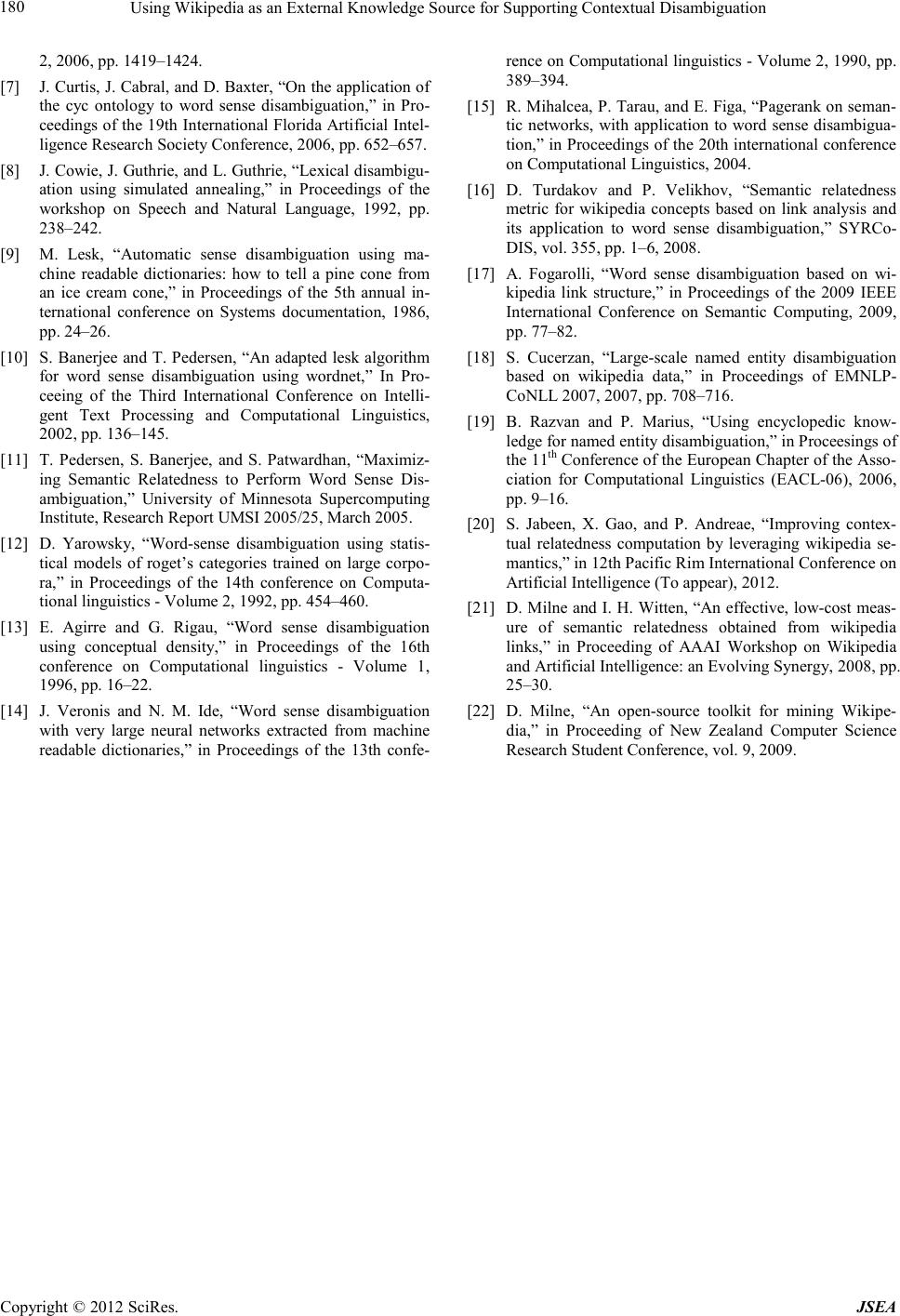 Using Wikipedia as an External Knowledge Source for Supporting Contextual Disambiguation Copyright © 2012 SciRes. JSEA 180 2, 2006, pp. 1419–1424. [7] J. C urtis, J. Cabral, and D . Baxter, “On t he appli cation of the cyc ontology to word sense disambiguation,” in Pro- ceedin gs of the 19th International Florida Artificial Intel- ligence Research Society Conference, 2 006, pp. 652–657. [8] J. Cowie, J. Guthrie, and L. Guthrie, “Lexical disa mbigu- ation using simulated annealing,” in Proceedings of the workshop on Speech and Natural Language, 1992, pp. 238–242. [9] M. Lesk, “Automatic sense disambiguation using ma- chine readable dictionaries: how to tell a pine cone from an ice cream cone,” in Proceedings of the 5th annual in- ternati onal conference on Systems documentation, 1986, pp. 24–26. [10] S. Banerjee and T. Pedersen, “An adapted lesk algorithm for word sense disambiguation using wordnet,” In Pro- ceeing of the Third International Conference on Intelli- gent Text Processing and Computational Linguistics, 2002, pp . 136–145. [11] T. Pedersen, S. Banerjee, and S. Patwardhan, “Maximiz- ing Semantic Relatedness to Perform Word Sense Dis- ambiguation,” University of Minnesota Supercomputing Institute, Research Report UMSI 200 5/25, Mar c h 20 05. [12] D. Yarowsky, “Word-sense disambiguation using statis- tical models of roget’s categories trained on large corpo- ra,” in Proceedings of the 14th conference on Computa- tional linguistics - Volume 2, 1992, pp. 454–460. [13] E. Agirre and G. Rigau, “Word sense disambiguation using conceptual density,” in Proceedings of the 16th conference on Computational linguistics - Volume 1, 1996, pp . 16–22. [14] J. Veronis and N. M. Ide, “Word sense disambiguation with very large neural networks extracted from machine readabl e dictionaries,” in Proceedings of the 13th confe- rence on Computational linguistics - Volume 2, 1990, pp. 389–394. [15] R . Mihalcea, P. Tarau, and E. Figa, “P agerank on se man- tic networks, with application to word sense disambigua- tion,” in Proceedings of the 20th international conference on Computational Linguistics, 2004. [16] D. Turdakov and P. Velikhov, “Semantic relatedness metric for wikipedia concepts based on link analysis and its application to word sense disambiguation,” SYRCo- DIS, vol . 35 5, pp. 1–6, 2008. [17] A. Fogarolli, “Word sense disambiguation based on wi- kipedia link structure,” in Proceedings of the 2009 IEEE International Conference on Semantic Computing, 2009, pp. 77–82. [18] S. Cucerzan, “Large-scale named entity disambi g uation based on wikipedia data,” in Proceedings of EMNLP- CoNLL 2007, 2007, pp. 708–716. [19] B. Razvan and P. Marius, “Using encyclopedic know- ledge for named entity disambiguation,” in Proceesings of the 11th Conference of the European Chapter of the Asso- ciation for Computational Linguistics (EACL-06), 2006, pp. 9–16. [20] S. Jabeen, X. Gao, and P. Andreae, “Improving contex- tual relatedness computation by leveraging wikipedia se- mantics, ” in 12th Paci fic R im International Conference on Artificial Intelligence (To appear), 2012. [21] D. Miln e and I. H. Witten, “An effective, low-cost meas- ure of semantic relatedness obtained from wikipedia links,” in Proceeding of AAAI Workshop on Wikipedia and Artificial Intelligence: an Evolving Synergy, 2008, pp. 25–30. [22] D. Milne, “An open-source toolkit for mining Wikipe- dia,” in Proceeding of New Zealand Computer Science Research Student Conference, vol. 9, 2009. |

